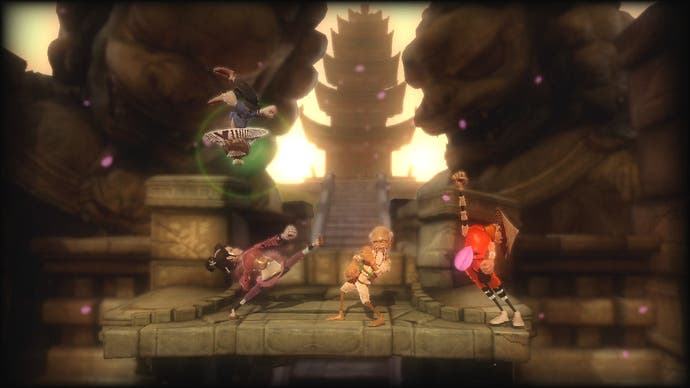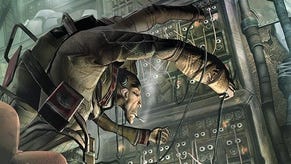Rag Doll Kung-Fu: Fists of Plastic
I got no strings.
Likewise, holding down the punch button and jolting the controller in a direction will cause your character to streak across the screen, taking out any fighters standing in the way. Finally, a slam attack, used to clear the ground around you, can be initiated by holding down the block button and jolting the controller up and then down. To use Chi to restore health you have to turn the controller over, an action that causes your character to float on the spot for a few seconds before restoring a portion of the health bar. It's a neat risk/reward system, incapacitating you both as a player and a character, ensuring that you only dare use the move when there's sufficient space and safety.
The bulk of the game is found in the default multiplayer mode, which presents four game types across eight Chinese-themed environments. Up to four players can fight simultaneously - a reduction of the original's eight player matches - with any empty slots filled by AI characters should you so desire. The four game modes are all available across almost all levels. Deathmatch and King of the Hill play out like standards, while Capture the Fish requires players to grab hold of a floppy fish and throw it into a giant basket without getting blocked by rivals and having it knocked from your hands. Dodgeball, the last of the modes, is far simpler than the game from which it borrows a name, supplying a single glowing bright blue explosive projectile, which must be thrown at competitors to score points.
To bolster the package for the lone player there are eight scored challenges. Each challenge has its own global leaderboard, encouraging competition, and each one explores a different aspect of the game's engine or rule-set. For example, in 'Sharpshooter' the aim is to fire a limitless supply of shurikens at barrel targets that randomly appear around a stage. Using the right analogue stick to aim, high scores are won by combo-ing together hits without scoring a miss. Over the three-minute challenge the size of the barrels reduces, increasing the challenge.
By contrast, in Acrobatics, the aim is to get to grips with the physics engine, swinging your character off ledges, getting up the momentum to make giant leaps across a gigantic set of monkey bars. Each challenge has three score thresholds, ranging from bronze through to gold. If you manage to pass the bronze medal score threshold (a task that is usually very straightforward) the next challenge is unlocked, while passing the medal breaks thereafter unlocks new items of clothing and body parts with which to customise your character.

While Fists of Plastic improves on its forebear in some areas, it also falls short in many others. There's no option to add a photograph of your own face to the characters via the PS Eye and the promised online multiplayer is nowhere to be seen. With the vastly simpler control scheme a lot of the original game's much vaunted scope for allowing players to develop their own fighting style has been stymied, the small set of stock moves making all-comers move and behave in similar ways. Indeed, the remake lends some credence to those tiresome PC proponents who are always accusing console titles of being poorer, dumber cousins to the one true home computing way.
But to be fair to developer Tarsier Studios, its purpose is quite different to Healey's in the original. It's clear that the team is trying to provide an accessible, fast-paced scrap-'em-up that can be enjoyed by all the family, not just autistic puppeteers. In that sense, the game's a modest success, offering a shallow but sometimes riotous playpen for up to four players to scrap away in visually interesting ways. But the slightness of the package means that this polished after-pub game will provide some short-term laughs but only minimal long-term nourishment.

